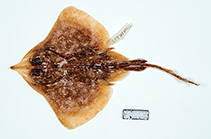| Diagnosis: |
This species can be distinguished from its congeners by the following set of characters: tail moderately is long, slender and weakly tapering posteriorly, length 51.0% of TL; first dorsal fin (D1) origin to tail tip 21.2% of TL; interdorsal space is rather short, distance 67.0% of D1 base length; caudal-fn base length is moderate, 1.3 times D1 base length; snout is rather short, moderately acute and pointed, preorbital snout length 13.7% of TL, preoral snout length 14.3% of TL, prenarial snout length 11.3% of TL; dorsal head length 20.7% of TL, the ventral head length 28.6% of TL; orbits and eyeballs are large, orbit diameter 1.3 times interorbital width, eyeball length (horizontal diameter) 1.2 times interorbital width; tail thorns are distinct, three rows in adult male; single nuchal thorn; trunk vertebrae 28 while predorsal tail vertebrae 43. Colouration: dorsal surface of disc pale brown, margin yellowish to pale brown; numerous yellowish spots and black fecks sparsely scattered on the dorsal disc, but not forming patches; dorsal disc no ocellated markings; snout area translucent; ventral surface of disc broadly white, the margin pale brown, darkly pigmented at pectoral-fin bases, posterior insertions of pectoral fins, nasal curtain, around cloaca, and sensory pore openings; ventral disc sensory pores in a W-shaped” distribution pattern, absent on abdominal region and near pelvic-fn base; clasper with external boss, cleft, funnel, pseudorhipidion, rhipidion, shield, spike, sentinel, and terminal bridge; the clasper skeleton with three dorsal terminal cartilages, single ventral terminal cartilage, two accessory terminal cartilages (accessory terminal 1 “Y-shaped”) (Ref. 126270). |
